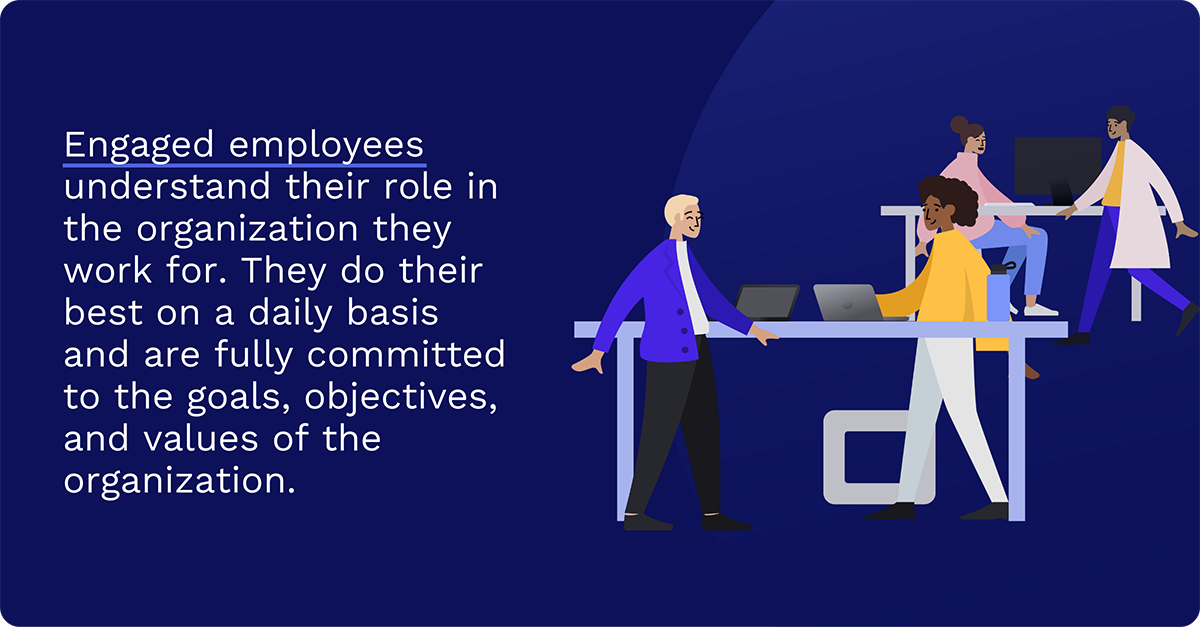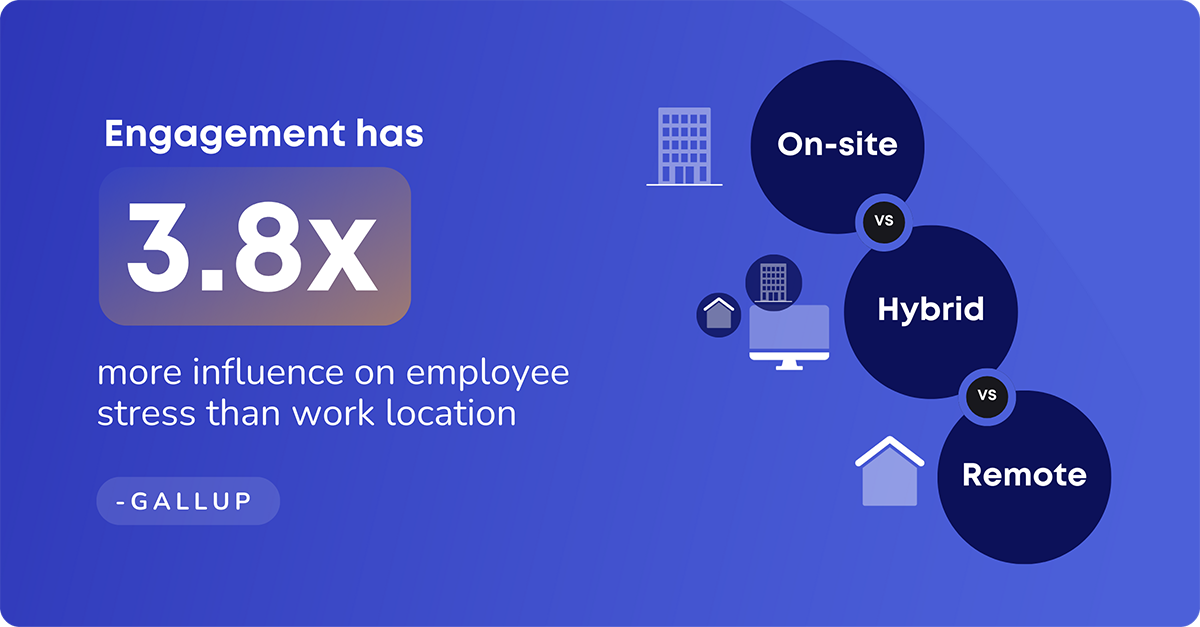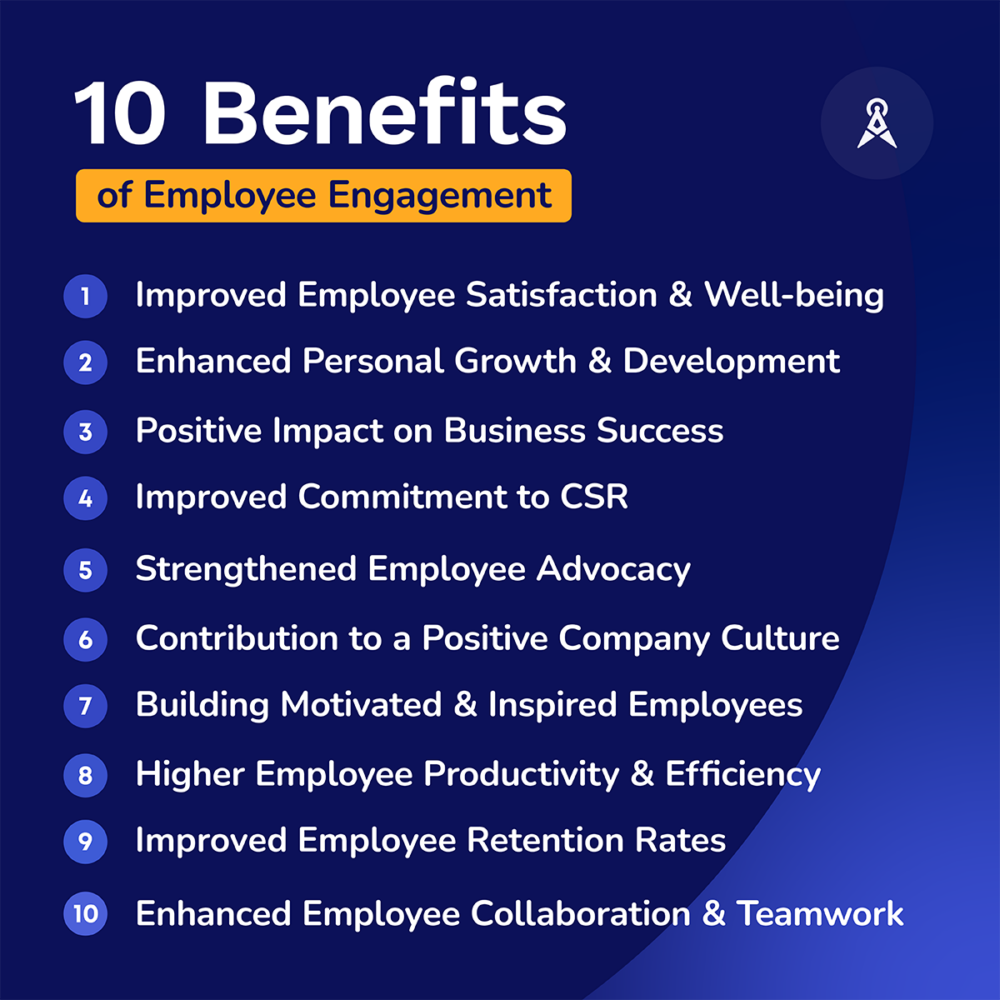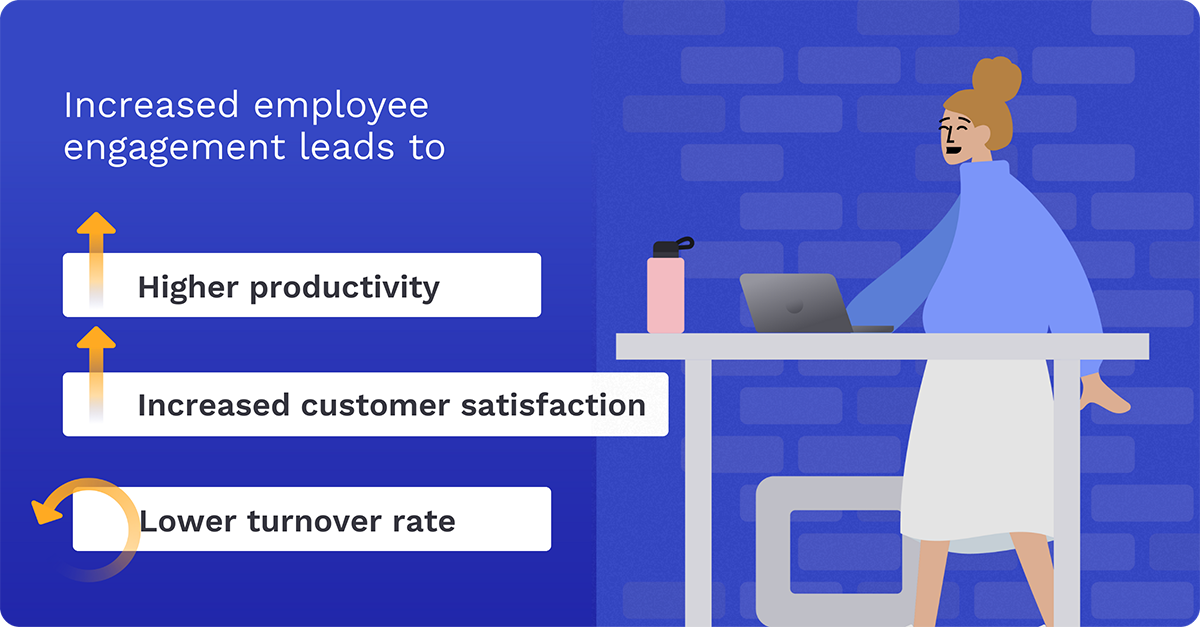Discover the numerous benefits of employee engagement in our insightful guide. Unlock the power of engaged employees for enhanced productivity.

.png)
It can be difficult to know what to include in an employee survey. That’s why we have created a template that you can use for FREE to ensure your employee surveys are engaging. Get the responses that will help you understand your audience.
Access NowLeading research undertaken by analytics and advisory firm Gallup shows that employee engagement is rising globally. But, at the same time, most of the world’s workers are still quite quitting their jobs. The top reason cited is a lack of engagement. The result is that they become psychologically disengaged from work. Then, because they don’t have supportive bonds with fellow employees, leaders, or the organization as a whole, they lack commitment and purpose. It becomes even more difficult in remote and hybrid environments when there is no physical contact.
“The majority of the global workforce is not engaged: most employees reluctantly head to work, lacking energy and passion for their jobs.” Gallup.
Since Gallup started tracking employee engagement metrics in 2009, they have surveyed 2.2 million employees from the global workforce. Their statistics indicate that there has been an increase in 250 million engaged employees worldwide from 2009 to 2023. Despite this, employees are more stressed, they say. Furthermore, stress levels have been rising for more than a decade, and a lot has to do with managers. Ultimately, engaging employees is the key to reducing stress.
Gallup’s recent State of the Global Workplace: 2023 Report maintains that those who aren’t engaged represent an $8.8-trillion “untapped productivity opportunity” for global workplaces. So, it isn’t rocket science to fathom that increasing employee engagement has enormous benefits.
With this in mind, we’re going to explore the advantages, importance, and benefits of employee engagement. We will also analyze the vital roles that leadership and company culture play in its promotion. After assessing the benefits it brings to organizations and individuals within it, we will suggest techniques to not only enhance engagement but also sustain it.
If you are eager to improve your team's effectiveness, contentment, loyalty, and accomplishments by implementing an efficient employee engagement strategy, then keep reading.
Employee engagement refers to the emotional commitment an employee has toward their organization and its goals. They're not just working for a paycheck or a promotion, they are engaged in their role and work to contribute to the success of the organization. They engage on a mental, emotional, and sometimes even physical level, which leads to considerably more effort and productivity.
Engaged employees understand their role in the organization they work for. They do their best on a daily basis and are fully committed to the goals, objectives, and values of the organization. Their motivation to contribute to the company’s success heightens their own sense of well-being and satisfaction. But it’s not just about feeling good and happy because happy employees aren’t always more productive. Similarly, employee engagement isn’t on par with employee satisfaction. Employees may be satisfied but they won’t necessarily put in additional effort to exceed their employer’s expectations. The key lies in the commitment, which employees who are passionate about their work have.

Ultimately, the focus of employee engagement is on employee emotions, thoughts, and behavior toward the organization and its members. Employee engagement becomes real when employees are emotionally invested in their organizations.
The benefits of employee engagement are multifarious and far-reaching. Because of increased emotional investment, higher engagement levels usually translate into better performance, lower turnover rates, increased productivity, and stronger customer satisfaction.
Employers are increasingly recognizing that an engaged workforce can be a significant source of competitive advantage. Engaged employees are motivated and aligned with the strategic objectives of their companies, ultimately leading to increased ROI and a better bottom line.
A highly engaged organization tends to have lower stress levels among its employees. Employee satisfaction often translates into customer satisfaction because an engaged employee is much more likely to provide better customer service. As such, opportunities to improve employee engagement can contribute enormously to the employer’s brand.
Engaged employees are enthusiastic about their work and often feel a strong, emotional connection to their organization. They feel engaged not just at the job level, but also at the organizational level, exhibiting a strong commitment that makes them go the extra mile.
The values and goals of the company and the employee are aligned in such a way that employees find their jobs fulfilling and they look forward to going to work each day. These employees feel connected to their organizations in a way that strengthens their loyalty and sets them apart.
Understanding employee engagement trends and recognizing an engaged employee is imperative for an organization’s progress. Engaged employees act as advocates for the organization, often promoting their employer on social media and other platforms. This kind of employee advocacy is invaluable for improving the employer’s brand among potential future employees and customers.
Stephen Richards Covey, the 20th-century author of The 7 Habits of Highly Effective People, was cognizant of the value of employee engagement long before its benefits became widely recognized. As an example, he recounts the exceptional service he received from a particular hotel. The hotel management had given employees the opportunity to write their own mission statements, making each of them feel personally driven to live up to their goals. It became a “we” thing rather than something they had been told to do.
“Always treat your employees exactly as you want them to treat your best customers.”
Stephen Richards Covey
Craft effective surveys to measure employee sentiment and boost engagement
.png)
Employee engagement relates to the level of commitment and involvement an employee has toward their organization and its values. It significantly influences employee behavior and subsequently affects the success and profitability of a business.
We’ve identified 10 of the most important benefits of employee engagement:
When employees feel engaged, they feel a stronger bond with the organization, which generally leads to greater job satisfaction. These engaged employees tend to have lower stress levels, better life balance accommodating both work and home life, and enhanced employee safety. According to the 2023 State of the Global Workplace Report, engagement has 3.8 times as much influence on employee stress as work location. It states that feelings of enthusiasm and involvement do more to reduce stress than other perceived benefits like where they are sitting.

This engagement results in happier employees contributing positively towards the employer brand, which directly leads to improved customer satisfaction and a better customer experience. Happiness activates positive emotions which drives engagement, says leadership coach Rodger Dean Duncan in a Forbes article, Workplace Engagement Is Good. Happiness Is Even Better. Ultimately, it helps us to reach important team goals.
Organizations that engage their employees provide ample opportunities for their employees to grow in their roles, enhancing job satisfaction. An employee engagement survey can be useful to both measure and improve employee engagement. At the same time, it gives employees the opportunity to voice their aspirations and expectations. This feedback can be used as a valuable tool for personal and organizational growth.
Highly engaged organizations are often more successful, and according to Gallup considerably more profitable. This is, quite simply, because when employees are happy and healthy they are more productive. It also affects company culture in a positive way.
Ultimately, with increased productivity, improved customer service, and a positive bottom line, businesses feel the profitable impact of an engaged workforce. Companies can improve employee engagement by implementing strategic plans such as employee engagement programs and initiatives.
Employee engagement is a powerful driver of positive change within organizations. Way beyond enhancing productivity and job satisfaction engaged employees often actively participate in corporate social responsibility (CSR) initiatives. Their enthusiasm and commitment not only foster a more supportive and inclusive workplace culture but also extend to their involvement in CSR activities.
Advocacy is a great strategy that employees can use to promote their organization's brand, products, or services through their own social media networks and personal channels. Spurred on because they feel engaged, employees can positively influence their networks, making them a part of the employer's brand promotion. It increases brand authenticity and trust and is an incredibly cost-effective form of marketing.
A positive company culture operates on the foundation of engaged employees. Employees feel connected to the core values of the organization, contributing to a supportive and nurturing environment.
Culture impacts every part of your business and relates to engagement, success, retention, and organizational performance. The Quantum Workplace 2022 Organizational Culture Research Report shows that engaged and disengaged employees operate very differently. For example, more than 60% of disengaged workers would quit their company in search of one with a better culture. But this figure drops by more than half, to 23% when employees are engaged.
It stands to reason that an impactful engagement initiative to motivate employees would be to create an environment of transparency and trust. Employee recognition and rewards are other powerful motivators.
A good way to get started is with regular engagement surveys that help to recognize the factors that contribute to the motivation and job satisfaction of employees.
Engaged employees are more productive, contributing positively to the company's bottom line.
A Gallup analysis shows that sales productivity was 18% higher when employees were engaged.
Highly engaged employees tend to stay with the organization for a longer period, reducing turnover rates. The same Gallup analysis shows that employee engagement in an organization is high, it can increase the retention rate by as much as 43%.
Additionally, highly engaged employees will actively participate in the company’s growth and introduce innovative ideas. This contributes to the overall success and reputation of the business.
Employee engagement creates an environment that promotes collaboration and teamwork. When employees feel connected with their peers and their roles, they actively contribute ideas and skills, enhancing overall team performance.

Employees who feel connected to their organization are more likely to take leadership roles and drive employee engagement. Their inherent understanding of the company's values and objectives allows them to inspire others and provide valuable insights.
Furthermore, when they become advocates of the organization, they enhance the value of the brand. Engaged employees act as ambassadors for the organization, sharing their positive experiences on social media and beyond. This leads to an improved brand image, which leads to increased customer loyalty.
One of the primary strategies for assessing an organization's health is to measure employee engagement. After all, the benefits of employee engagement are manifold. For example, increased employee engagement leads to higher productivity, lower turnover rate, and increased customer satisfaction.

One way to gauge this crucial factor is by using an employee engagement survey. This is a tool that is designed to provide valuable insights about your team's morale, commitment, and satisfaction.
Highly engaged organizations invest in these surveys so they can discover the factors driving engagement. They also want to uncover areas where they might be falling short. By identifying important elements, executives can create action plans to improve employee engagement and ensure their employees feel connected.
So, how do these surveys work?
An employee engagement survey is an invaluable tool that provides a snapshot of your team's energy and commitment to the company's values and goals. They are based on questionnaires that often include a range of topics. For instance, they may focus on life balance, employer brand, and employee safety. Importantly, they give employees a chance to voice their thoughts, feelings, and concerns anonymously if they wish.
The statistics obtained from an employee survey can help to identify trends over time, which is invaluable. After all, understanding employee engagement trends is crucial for evolving your engagement strategy and keeping the workforce motivated and committed.
When employees are eager to participate in these surveys, they generally exhibit an implicit sense of engagement. However, low productivity and high stress levels could indicate engagement issues, signaling a need for the employer to promote a more conducive environment. Employee engagement software can automate and improve this process, providing real-time insights and flagging potential problems.
Constructive employee engagement programs and initiatives reflect strong management and leadership, contributing to an excellent overall employee experience. There is no doubt that employee engagement software tools can be instrumental in improving engagement through regular surveys, opportunities for feedback, and open forums for discussion.
Craft effective surveys to measure employee sentiment and boost engagement
.png)
Creating a supportive and positive company culture is a powerful way to improve employee engagement. It emphasizes the organization's dedication to employee satisfaction. This, in turn, fosters a sense of loyalty and contributes to higher job satisfaction. A well-established company culture is more than just a solid weekly or monthly paycheck. It has the potential to make employees feel valued, appreciated, and included, driving their readiness to work harder.
Kincentric explains company culture in its Global Trends in Employee Engagement 2022 report. It refers to the constant and obvious patterns of conduct displayed by leaders that are passed down and across to employees in a business. High consistency between values and actual experience results in:
The report quotes words that employees commonly use to describe their workplace culture. When they are highly engaged they say it is caring, supportive, positive, and engaging. When they aren’t highly engaged, they say it is demanding, disorganized, stressful, and professional.
A thriving company culture also attracts top talent, strengthening the organization's brand and enriching the employee experience. This directly influences an organization's bottom line, as organizations brimming with engaged employees perform demonstrably better than their counterparts lacking in this crucial aspect.
The role of company culture in enhancing employee engagement is multidimensional. It serves as the foundation for employee advocacy and amplifies customer success stories on social media. A positive company culture also reduces stress levels and encourages a healthy work-home life balance for employees.
From the perspective of customer service, engaged employees are more likely to deliver a superb customer experience, fostering client loyalty, and driving customer satisfaction. Also, employees who feel engaged are more likely to stay with the company for longer. This lowers turnover rates and saves financial costs associated with recruitment and training. They also tend to be more innovative and collaborate better, in this way increasing productivity.
Creating a culture of engagement doesn't happen overnight. It requires consistent efforts from all levels of the organization, especially direct managers. Leaders play a crucial role in setting the tone for engagement and fostering an environment where employees feel valued. Open communication, recognition and rewards systems, as well as engagement initiatives, are all part of building a highly engaged staff.
It is also important to measure, iterate, and optimize engagement strategies continuously. Never shy away from re-evaluating current processes or implementing new employee engagement programs when necessary. Utilizing additional employee engagement resources like white papers, case studies, and frequently asked questions, can also contribute valuable insights to improve engagement strategies.
At the end of the day, applying employee engagement best practices to build a positive company culture will form the bedrock of highly engaged organizations. By prioritizing and investing in these initiatives, businesses can enhance employee satisfaction, productivity, and ultimately, their all-important profitability.
If you are an employer, building a highly engaged organization should be at the top of your priority list. When your employees feel engaged, they work harder. They also contribute more to their teams and are generally happier both at work and in their home lives.
A successful strategy often starts with an employee engagement survey. As we have already said, this is a valuable tool that provides direct insight into your employees' sentiments and aspirations. It can offer valuable insights into various aspects of your company culture, as well as development opportunities, and the overall employee experience.
But, you need to foster open communication channels where employees can voice their concerns without fear of negative repercussions. Also, social media platforms can serve as additional employee engagement resources and boost your employer's brand.
Offering employee empowerment initiatives like training, enabling work-life balance, reducing stress levels, and addressing safety concerns can go a long way to motivate your workforce. Research shows that such measures of support and intervention can directly contribute to higher productivity and lower turnover rates.
Also, constant feedback from a direct manager, peer-to-peer recognition, and frequent all-hands meetings on various topics can act as significant motivators. These feedback mechanisms can make your employees feel connected and even inspire them to perform better.
Offering competitive salaries, developing a positive company culture, and encouraging social interaction between staff members are proven employee engagement initiatives. Building a culture where your employees' contributions are recognized and rewarded can motivate them significantly, leading to improved engagement.
Understanding your current employee engagement statistics provides a benchmark to measure improvements. You can do this by conducting regular employee engagement surveys. Using employee engagement software automates this process, offering a level of objectivity and efficiency.
Your strategy should accommodate both customer satisfaction and customer success stories to further promote employee engagement. A dedication to improving your customer experiences can help increase your employee engagement.
One critical step in developing an effective engagement strategy is to share positive customer feedback with your employees. Displaying customer success stories on your company intranet or social media channels will not only inspire your employees but can also help foster a close-knit working community.
Engaged employees have greater job satisfaction. Their productivity is increased and they are less likely to leave the organization. This leads to a much stronger bottom line financially. Not only do engaged employees impact customer satisfaction positively, but because retention is increased, turnover costs are reduced.
When employers invest in employee engagement programs, they improve the quality of work their employees deliver. They also encourage creativity and heighten levels of commitment amongst their staff members.
Interestingly, employee engagement transcends the individual and can significantly impact a company's customer service quality. Engaged employees are often more receptive to customer needs, leading to improved customer service and an enhanced customer experience overall.
The benefits of employee engagement extend beyond the office. With happier, more satisfied employees comes a more positive home-life balance. This, in turn, can result in lower stress levels and a healthier overall life for your workforce.
Cerkl Broadcast’s suite of internal communication software offers a great solution for increased employee engagement. It enables internal communicators to manage information, making it instantly accessible to employees through their chosen channels of communication.
Broadcast is a versatile platform that can be used to keep employees connected and to encourage collaboration. You can plan the timing and frequency of messages to suit your chosen audience. You can also segment your audience based on criteria like department, role, or location. Broadcast's feedback and analytics tools are particularly helpful for employee engagement initiatives. They allow communicators to measure message impact as well as make strategic adjustments for future comms.
We’ve mentioned how useful employee engagement and feedback surveys can be. Job satisfaction, employee morale, and company culture surveys can also be very useful. Cerkl Broadcast will enable you to compile, conduct, and analyze the full range of surveys. A great feature is that you can add a Pulse Survey to your Email Blasts.
Presuming you recognize the benefits of employee engagement, are you ready to improve employee engagement in your organization? Cerkl Broadcast can help you develop a winning strategy.
.png)
Craft effective surveys to measure employee sentiment and boost engagement
How to define employee engagement? Employee engagement is the emotional commitment and dedication employees have toward their work. It is manifested through their enthusiasm, passion, and willingness to contribute to their organization's success. When employees are engaged, there is a strong connection between them and their work. This results in higher productivity, increased job satisfaction, and a sense of belonging within the company.
What are the most important benefits of employee engagement? Important benefits of employee engagement include improved employee satisfaction, increased personal growth, motivation, and productivity, and a willingness of employees to contribute to a positive company culture.
How does engagement influence employee performance? Employee engagement has a positive influence on employee performance because it encourages a sense of motivation, dedication, and ownership in their work. This leads to increased productivity, higher-quality output, and a greater commitment to achieving organizational goals. Engaged employees are also more likely to be proactive, innovative, and persistent in their efforts, contributing to improved job performance and business outcomes.

Craft effective surveys to measure employee sentiment and boost engagement